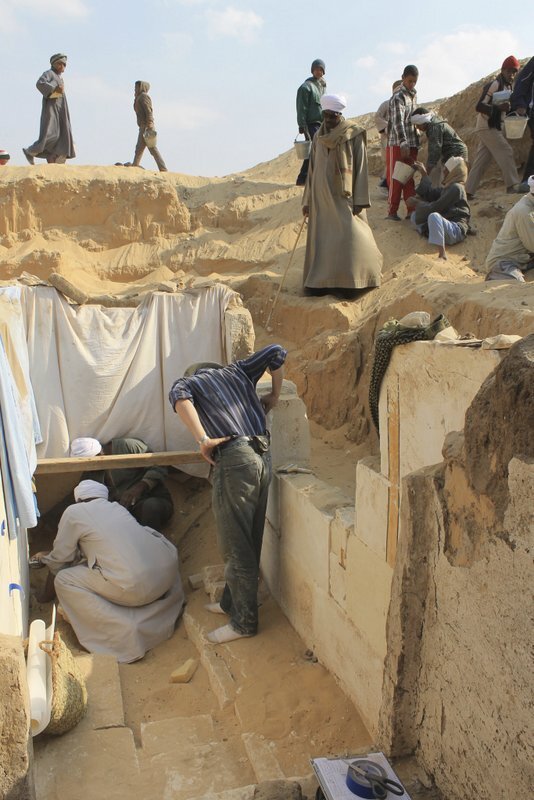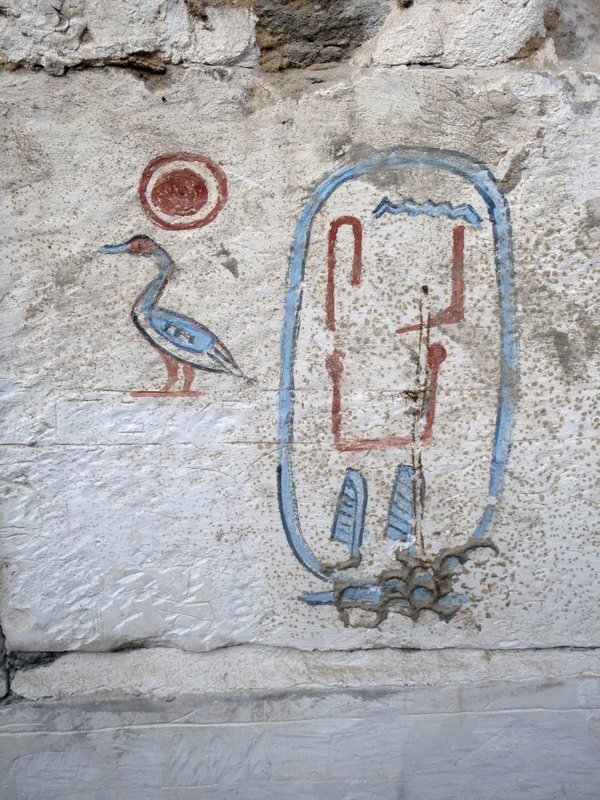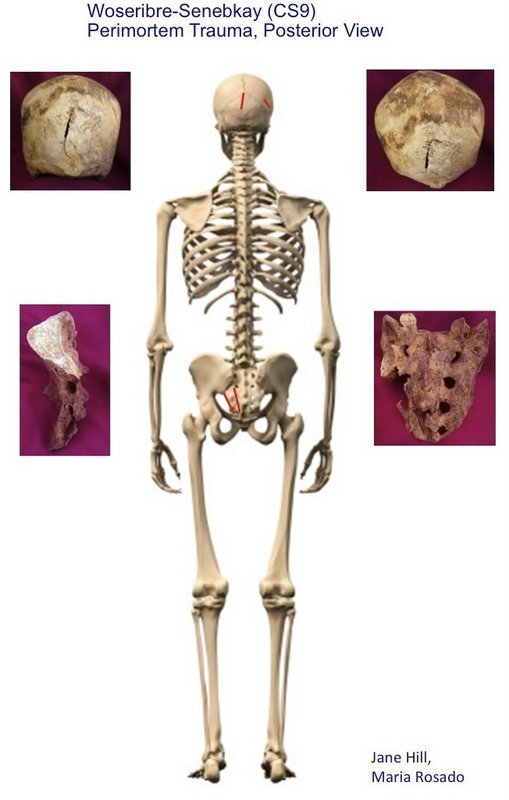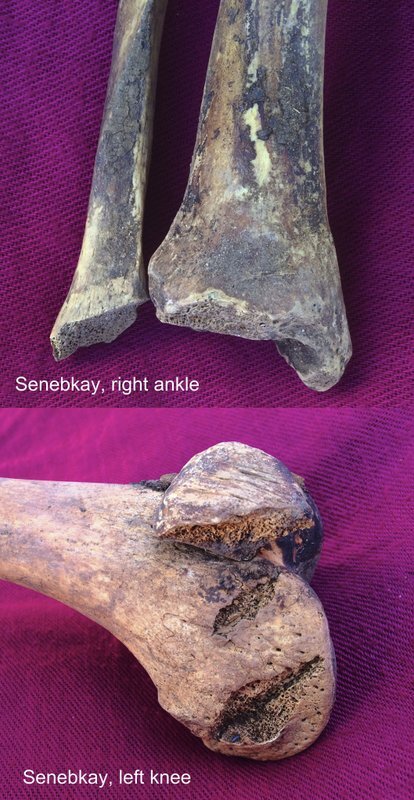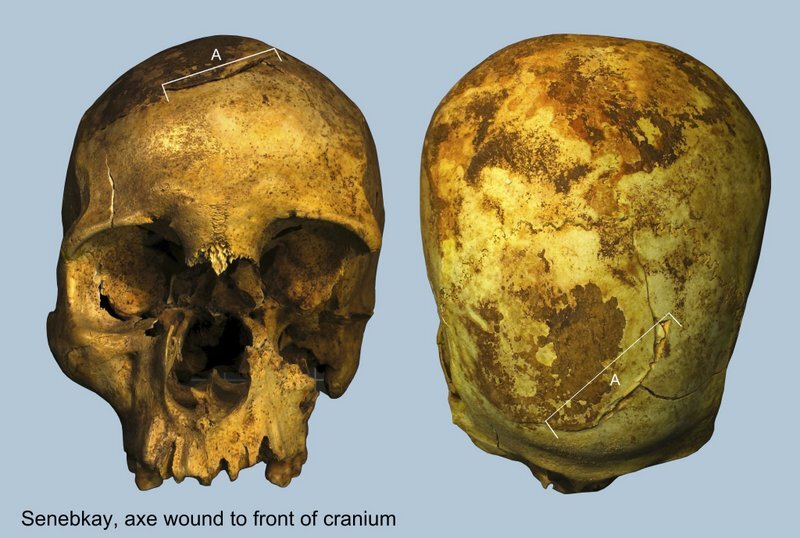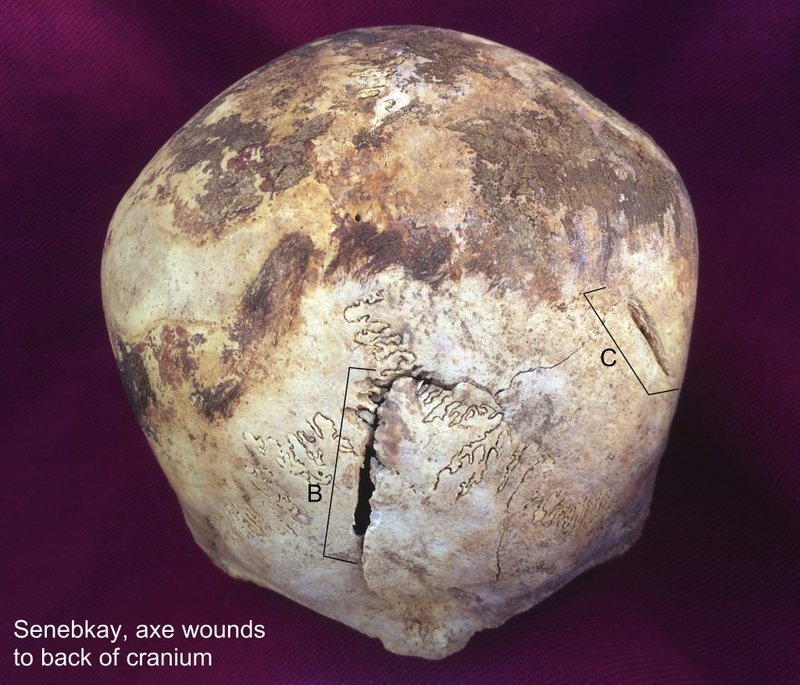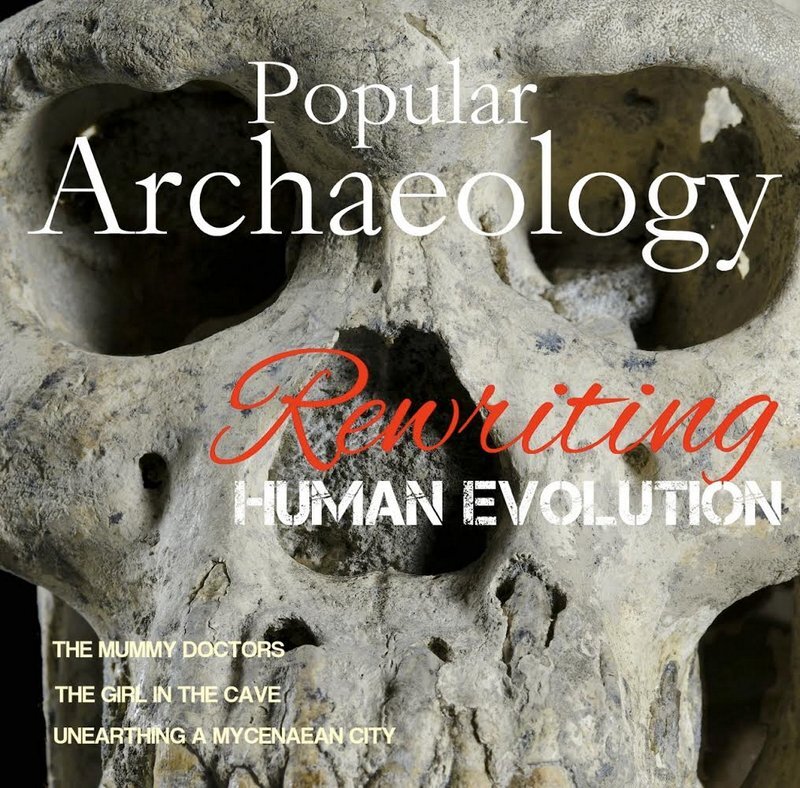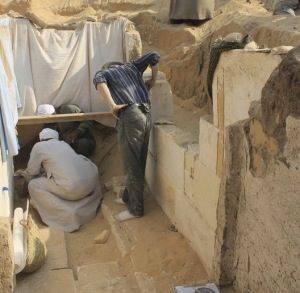
He may have led a king’s life, but new forensic evidence gleaned from the remains of Pharaoh Senebkay indicates that the Egyptian ruler died in battle—the earliest known pharaoh to have done so—viciously attacked by multiple assailants.
Last year, the tomb of king Senebkay (ca. 1650–1600 BCE) was discovered at the site of Abydos by researchers from the University of Pennsylvania Museum working in association with Egypt’s Ministry of Antiquities. Now the team led by Dr. Josef Wegner of the Penn Museum has completed a detailed study of Senebkay’s skeleton, as well as the remains of several other kings whose tombs have been discovered nearby. The 2014-15 research is supported by the Penn Museum, with additional support from the National Geographic Society Expeditions Council.
“Forensic analysis has provided some new answers about the life, and death, of this ancient Egyptian king,” noted Dr. Wegner, “while raising a host of new questions about both Senebkay, and the Second Intermediate Period of which he was a part.”
______________________________________
Team members work to excavate the burial chamber of the pharaoh Woseribre Senebkay, with sheets covering a painted wall decoration. Photo: Josef Wegner, Penn Museum.
_____________________________________
At left, the sun disc and goose means “Son of Re” (or Ra), the Egyptian sun god. The cartouche at right spells the name of the pharaoh, Senebkay, whose body was interred in this tomb. Photo: Jennifer Wegner, Penn Museum.
______________________________________
A Warrior King
Pharaoh Woseribre Senebkay, who lived during the later part of Egypt’s Second Intermediate Period (ca. 1650–1550 BCE), is now the earliest Egyptian pharaoh whose remains show he died in battle. Detailed analysis by Dr. Maria Rosado and Dr. Jane Hill of Rowan University has documented an extensive array of wounds on Senebkay’s skeleton showing he died aged 35-40 years old during a vicious assault from multiple assailants. The king’s skeleton has an astounding eighteen wounds that penetrated to the bone. The trauma includes major cuts to his feet, ankles, knees, hands, and lower back. Three major blows to Senebkay’s skull preserve the distinctive size and curvature of battle axes used during Egypt’s Second Intermediate Period. This evidence indicates the king died violently during a military confrontation, or in an ambush.
Emerging Role of the Horse
The patterns of wounds to Senebkay’s body suggest he was attacked while in an elevated position relative to his assailants, quite possibly mounted on horseback. Another surprising result of the osteological analysis is that muscle attachments on Senebkay’s femurs and pelvis indicate he spent a significant amount of his adult life as a horse rider. Another king’s body discovered this year in a tomb close to that of Senebkay also shows evidence for horse riding, suggesting these Second Intermediate Period kings buried at Abydos were accomplished horsemen. Senebkay and other royal remains at Abydos provide valuable new insight into the early introduction of the horse (Equus ferus caballus) to Egypt. Although use of horseback riding in warfare was not common until after the Bronze Age, the Egyptians appear to have been mastering the use of horses during the Second Intermediate Period. Horseback riding may have played a growing role in military movements during this era, even before the full advent of chariot technology in Egypt, which occurred slightly later, at the beginning of Egypt’s New Kingdom (ca. 1550 BCE).
_______________________________________
Schematic showing the distribution of traumatic battle wounds to Senebkay: front view. Image: Dr. Jane Hill.
_________________________________________
Schematic showing the distribution of traumatic battle wounds to Senebkay: rear view. Image: Dr. Jane Hill.
____________________________________
Image composite depicting the right ankle and left knee of Woseribre Senebkay’s skeleton. The patterns of wounds to Senebkay’s body suggest he was attacked while in an elevated position relative to his assailants, quite possibly mounted on horseback. Image: Jane Hill and Josef Wegner.
______________________________________
Front and top views of Woseribre Senebkay’s skull, indicating the location of an axe wound to the front of the cranium. This and two other major blows to Senebkay’s skull preserve the distinctive size and curvature of battle axes used during Egypt’s Second Intermediate Period. Photo: Josef Wegner, Penn Museum.
______________________________________
Rear view of Woseribre Senebkay’s skull, indicating the locations of two axe wounds to the back of the cranium. Photo: Jane Hill and Josef Wegner.
_____________________________________
A Battle with Whom?
The death of Senebkay in battle appears to have taken place at considerable distance from his burial place at Abydos. The king’s body also shows that significant time elapsed between his death and preparation of the body for burial. What remains a mystery is where the king died and who Senebkay’s opponents were. Possibly the king died in battle fighting against the Hyksos kings who at that time ruled northern Egypt from their capital at Avaris in the Nile Delta. However, Senebkay may have died in struggles against enemies in the south of Egypt. Historical records dating to Senebkay’s lifetime record at least one attempted invasion of Upper Egypt by a large military force from Nubia to the south. Alternatively, Senebkay may have had other political opponents, possibly kings based at Thebes.
Who was Senebkay? Tombs of seven other kings have now been excavated at Abydos opening a new window onto one of Ancient Egypt’s most obscure periods. It appears probable that Senebkay and these other rulers form a short-lived dynasty who chose Abydos as their burial ground. Continued excavations of the Penn Museum researchers in collaboration with the National Geographic Society hope to shed light on Senebkay and the other kings buried near him.
_______________________________________
A facial reconstruction of the pharaoh Senebkay based on detailed cranial study, by Mireya Poblete Arias. Analysis of the king’s skeleton shows that he died at an age of 35-40 years. Image: Mireya Poblete Arias.
____________________________________
Abydos and the Penn Museum
Penn Museum scholars have been excavating at the site of Abydos since 1967, as part of the Pennsylvania-Yale-Institute of Fine Arts/NYU Expedition to Abydos. Abydos is located on the western side of the Nile in Upper Egypt and was a religious center associated with the veneration of the funerary god Osiris. Dr. Josef Wegner has been excavating at the site of Abydos since 1994. Excavations in the area of South Abydos have revealed a thriving royal cult center that developed around the subterranean tomb of pharaoh Senwosret III located at the area called Anubis-Mountain, where Senebkay’s tomb and other Second Intermediate Period tombs have been found.
_________________________________
Source: Press release provided by the University of Pennsylvania Museum of Archaeology and Anthropology
About the Penn Museum
Founded in 1887, the Penn Museum (the University of Pennsylvania Museum of Archaeology and Anthropology), 3260 South Street in Philadelphia, is one of the world’s great archaeology and anthropology research museums, and the largest university museum in the United States. With nearly one million objects in the collection, the Penn Museum encapsulates and illustrates the human story: who we are and where we came from. A dynamic research institution with many ongoing research projects, the Museum is an engaging place of discovery. The Museum’s mandate of research, teaching, collections stewardship, and public engagement are the four “pillars” of the Museum’s expansive mission: to transform understanding of the human experience. Penn Museum can be found on the web at www.penn.museum. For general information call 215.898.4000.
__________________________________________
Read about the most fascinating discoveries with a premium subscription to Popular Archaeology Magazine. Find out what Popular Archaeology Magazine is all about. AND MORE:
On the go? Get the smartphone version of Popular Archaeology as an app or as an ebook.
Just released!
The special new premium quality print edition of Popular Archaeology Magazine. A beautiful volume for the coffee table.
Travel and learn with Far Horizons.
____________________________________________
Popular Archaeology’s annual Discovery Edition eBook is a selection of the best stories published in Popular Archaeology Magazine in past issues, with an emphasis on some of the most significant, groundbreaking, or fascinating discoveries in the fields of archaeology and paleoanthropology and related fields. At least some of the articles have been updated or revised specifically for the Discovery edition. We can confidently say that there is no other single issue of an archaeology-related magazine, paper print or online, that contains as much major feature article content as this one. The latest issue, volume 2, has just been released. Go to the Discovery edition page for more information.

